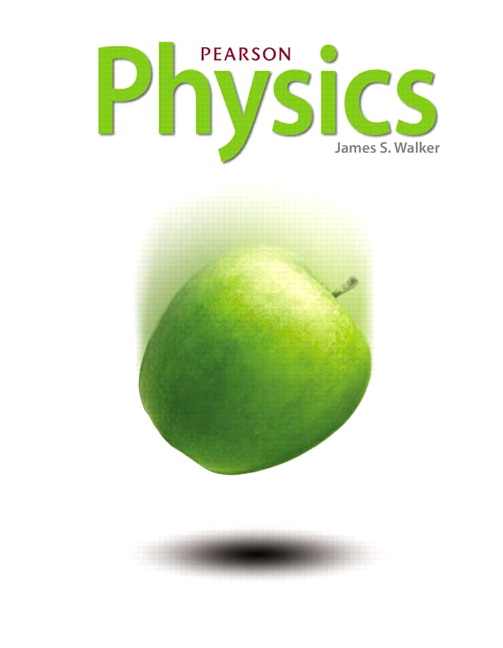
All Solutions
Page 366: Lesson Check
These collisions can be thought of as friction between the layers of water. This friction turns the kinetic energy of water into random thermal motion energy, that is thermal energy. Hence the temperature increases.
Hence, the higher the specific heat capacity of a given substance, the harder it is to raise its temperature.
– Thermal energy of the sample is lost through heat.
– This heat can either be transferred to the water in the calorimeter, or leave the calorimeter entirely.
– The calorimeter is almost completely insulated, meaning there is no heat exchange with the surroundings, so no heat can enter or leave it.
– Since no heat leaves the calorimeter this implies that it must be transferred to the water inside.
This can be seen in the following formula:
$$
begin{equation*}
Q = m , c , Delta T
end{equation*}
$$
Since our bodies A and B have the same change of thermal energy and mass we deduce that the following holds:
$$
begin{equation*}
c_a , Delta T_a = c_b , Delta T_b
end{equation*}
$$
Since we know that:
$$
begin{align*}
Delta T_a > Delta T_b
end{align*}
$$
It follows that
$$
begin{equation*}
c_a < c_b
end{equation*}
$$
So we conclude that the specific heat capacity of object A is less that the specific heat capacity of object B.
Therefore a large block of gold and small gold coin have same specific heat capacity.
– The mass of our piece of copper pipe $m = 0.75text{ kg}$
– The change in temperature of the pipe $Delta T = 15text{textdegree}text{C}$
– The specific heat capacity of copper $c = 387 frac{text{J}}{text{kg}text{textdegree}text{C}}$
We know that the thermal energy needed to raise a body’s temperature is proportional to its mass, and change of temperature.
We can write:
$$
begin{equation*}
Q = m , c , Delta T
end{equation*}
$$
when we have read $c = 387 frac{text{J}}{text{kg}text{textdegree}text{C}}$ from the table.
Plugging in the values we get:
$$
begin{align*}
Q = 0.75text{ kg} cdot 387 frac{text{J}}{text{kg}text{textdegree}text{C}} cdot 15text{textdegree}text{C} = 4.3 cdot 10^3text{ J}
end{align*}
$$
$Q = 4.3 cdot 10^3text{ J}$ was the sought after thermal energy.
begin{align*}
Q = 4.3 cdot 10^3text{ J}
end{align*}
$$
– The specific thermal capacity of the orange, that is of water $c_w = 4186 frac{text{J}}{text{kg}text{textdegree}text{C}}$
– The mass of the orange $m_w = 0.20 text{ kg}$
– The change in temperature of the orange $Delta T = (22text{textdegree}text{C} – 15textdegree7C)$
– The well known formula for the change in thermal energy gives us:
$$
begin{equation*}
Q = m_w , c_w , Delta T
end{equation*}
$$
Plugging in the known values we get:
$$
begin{align*}
Q & = (0.20text{ kg}) left(4186 frac{text{J}}{text{kg}text{textdegree}text{C}} right) left(7text{textdegree}text{C} right) approx 5.9 cdot 10^3text{ J}
end{align*}
$$
begin{align*}
Q approx 5.9 cdot 10^3text{ J}
end{align*}
$$
– The specific heat capacity of ice $c = 2090 frac{text{J}}{text{kg}text{textdegree}text{C}}$
– The mass of the block of ice $m = 1.4text{ kg}$
– The initial temperature of the block if ice $T_i = -10text{textdegree}text{C}$
– The amount of thermal energy added to the block $Q = 6200text{ J}$
The change in thermal energy of the block is expressed as follows:
$$
begin{equation*}
Q = m , c , Delta T
end{equation*}
$$
The change in temperature is expressed:
$$
begin{equation*}
Delta T = T_f – T_i
end{equation*}
$$
Using this our formula becomes:
$$
begin{equation*}
Q = m , c (T_f – T_i)
end{equation*}
$$
Rearranging to solve for $T_f$, and plugging in the values we get:
$$
begin{align*}
T_f &= frac{Q}{m , c} + T_i =
frac{6200text{J}}{(1.4text{ kg}) left(2090 frac{text{J}}{text{kg}text{textdegree}text{C}} right)} + (-10text{textdegree}text{C}) = -7.9text{textdegree}text{C}
end{align*}
$$
This is the sough after final temperature of the ice
begin{align*}
T_f = -7.9text{textdegree}text{C}
end{align*}
$$
– The mass of our lead bullet $m = 5text{ g}$
– The initial speed of the bullet $v = 250 frac{text{m}}{text{s}}$
– The specific heat capacity for lead $c = 128 frac{text{J}}{text{kg}text{textdegree}text{C}}$
We will find the total kinetic energy of the bullet:
$$
begin{equation*}
E_k = frac{m , v^2}{2} = frac{0.005text{ kg} cdot left(250 frac{text{m}}{text{s}} right)^2}{2} = 156.25text{ J}
end{equation*}
$$
Half of this energy goes into heating the bullet, so we can write:
$$
begin{align*}
Q = frac{E_k}{2} = frac{156.25text{ J}}{2} = 78.125text{ J}
end{align*}
$$
This leads to a change in the temperature described as follows:
$$
begin{equation*}
Q = m , c , Delta T
end{equation*}
$$
rearranging:
$$
begin{align*}
Delta T = frac{Q}{m , c} = frac{78.125text{ J}}{0.005text{ kg} cdot 128 frac{text{J}}{text{kg}text{textdegree}text{C}}} = 122.07text{textdegree}text{C} approx 122text{textdegree}text{C}
end{align*}
$$
begin{align*}
Delta T = 122text{textdegree}text{C}
end{align*}
$$
$$
begin{align*}
c&=frac{Q}{mDelta T}\
c&=frac{mv^2}{4mDelta T}\
Delta T &=frac{v^2}{4c}\
&=frac{250^2}{4*128}\
&=`boxed{color{#4257b2}{122^circ c}}
end{align*}
$$
tt{$Delta T= 122^circ c$}
$$
Haven't found what you were looking for?
Search for samples, answers to your questions and flashcards

